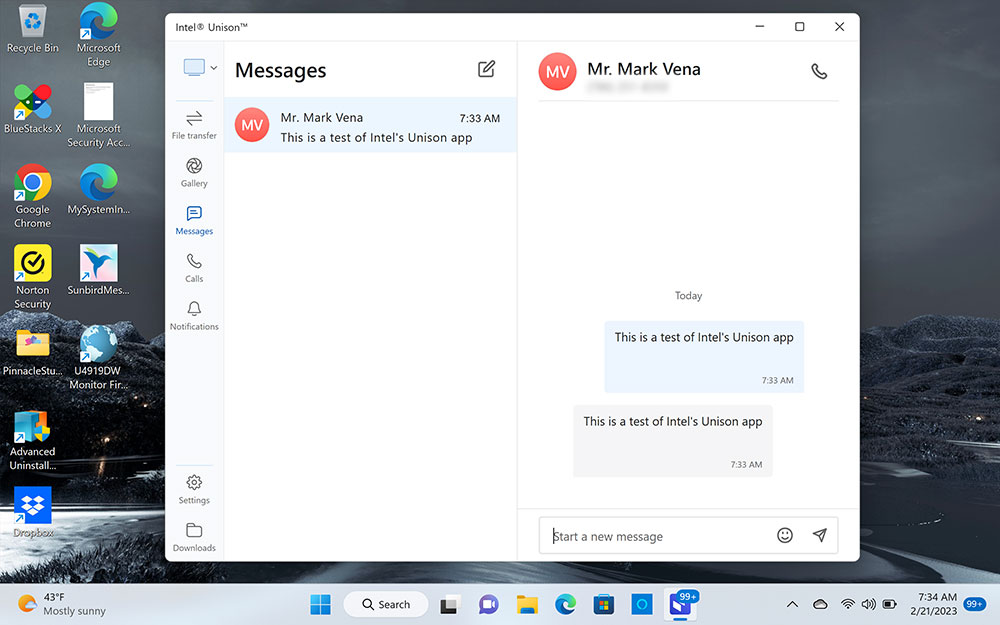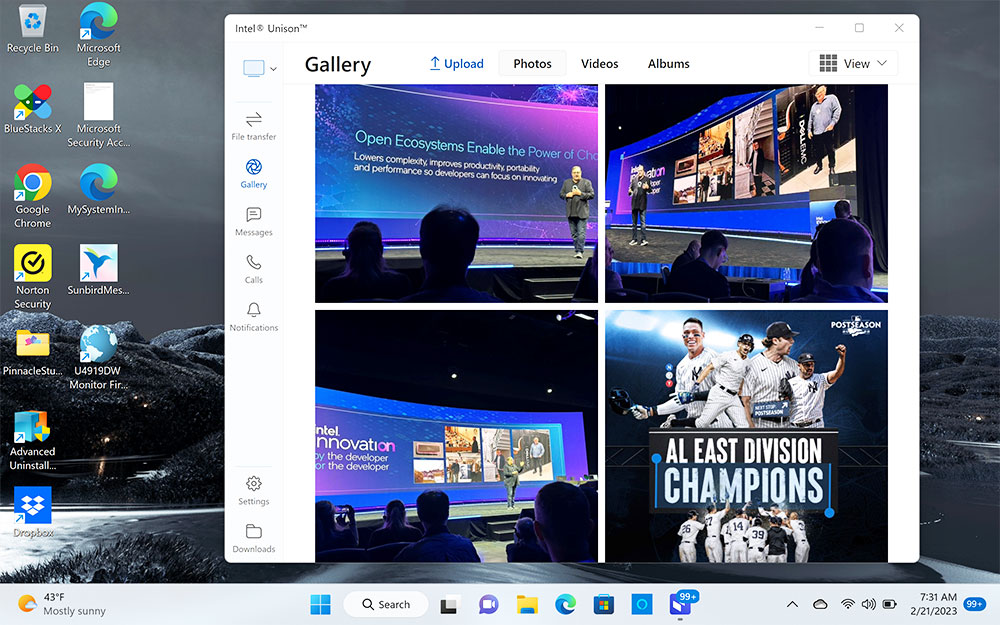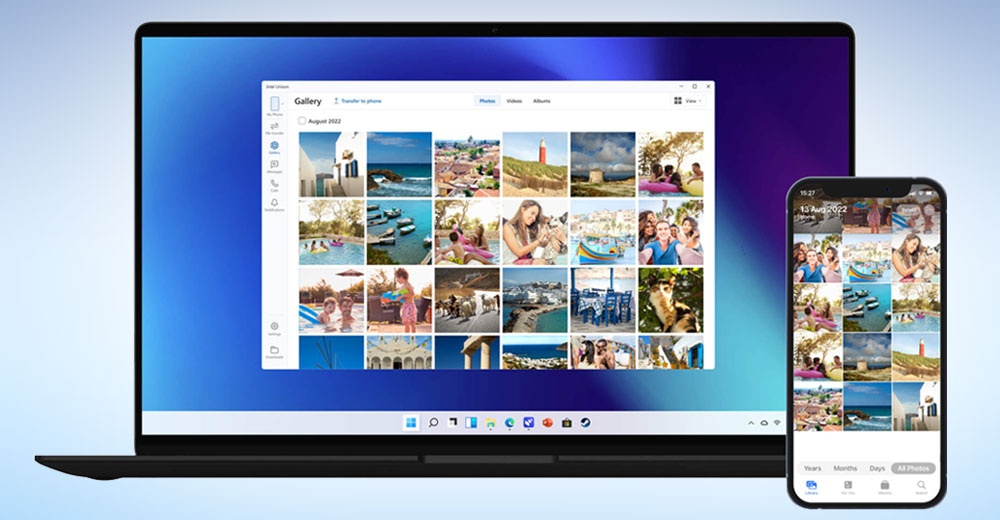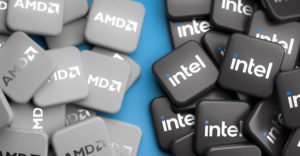The inability to share data easily and reliably between a smartphone, laptop, or desktop has been a source of aggravation for Windows PC users who also possess an iPhone.
Apple has solidified a strong ecosystem reputation with its products and core device operating systems by highlighting the advantages of enabling files, text messages, and even the continuity experience between its Mac computers, iPads, and iPhones.
Apple reportedly had roughly 1.2 billion active iPhones at the end of 2022, and Microsoft maintains that there are approximately 1.4 billion Windows 10 or 11 users.
Given Microsoft’s hefty market share in the PC space, that would translate to hundreds of millions of Windows users with iPhones who can’t participate in Apple’s ecosystem, particularly with shared text messaging using a Windows PC.
The ability to seamlessly integrate the PC and mobile experience so that all our devices work together with minimal friction offers nearly endless user benefits. Multiple mobile and client PC operating systems must work together to enable maximum consumer interoperability fully.
To bridge this gap which has existed for years, a few PC makers, notably Dell, have made valiant attempts to do this with varying degrees of success. With its Link To Windows app for mobile and the Windows Phone Link app, Microsoft has tried to make iOS devices a more compelling component of the Windows ecosystem. My experience with these solutions has been a mixed bag of irritation with modest usefulness.
Flash forward to 2023: Intel recently released Unison, which it expects desktop and laptop PC OEMs to embrace.
The Benefits of Unison
I recently downloaded Intel’s Unison software from the Microsoft App store and tested it on my Evo-certified HP Elite Dragonfly G3 laptop. Pairing it with my iPhone 14 Pro Max only required scanning a QR code and following the on-screen instructions to grant the PC client access to my contacts, message logs, etc.
Because Apple has steadfastly refused to provide the necessary software support to integrate iOS devices into the Windows ecosystem directly, companies like Microsoft and Intel have been exploring “creative” (translated: workaround) ways to bring the Windows and iOS device ecosystems together without Apple’s explicit support.
With Unison, users can access and manage their smartphones from a laptop, minimizing the disturbances to production that frequent device switching might bring about.
Your attention may be diverted if you attempt to concentrate on work on your laptop while managing phone calls, SMSs, and app alerts on your mobile device. Consolidating those distractions to your laptop screen might be helpful if completely suppressing them isn’t possible.
The Unison app has a Do Not Disturb (DND) toggle that can halt all app notifications, allowing users to stay focused on work without being distracted by their phones.
Users of Unison can do many things, including setting aside their phones which are connected by Unison to their laptop, and then make and receive calls and send text messages from the computer. Although some of this capability is not new, this functionality is cool because it works with phones running iOS and Android and has a wide range of network configurations.
Screenovate at the Core
The technology included in Unison comes from Screenovate. In 2021, Intel purchased the Israeli business that pioneered smartphone-to-display projection and was developing various cross-device experiences.
Some system OEMs had already incorporated Screenovate’s background technology and rebranded it in their own solutions, including Dell with its Dell Mobile Connect (which, incidentally, is being sunset) and HP with Phonewise, which the company discontinued in 2019. Ironically, you might already have even used Screenovate technology without realizing it.
Intel maintains that throughout the integration of Screenovate’s architecture into Unison, it placed a significant emphasis on platform power saving and UI and networking behavior improvements. The power-related efforts have stressed that Unison won’t be a big battery drainer on the host laptop because it runs naturally in the background.
Complicated Connectivity
Various hardware and communication technologies are now juggled by many hybrid and remote employees switching from office to home-based work and shifting between Wi-Fi networks, Bluetooth connections, and cellular-only settings.
Although Intel promises a seamless experience across WAN, Wi-Fi, cloud, cellular, and Bluetooth connections, and it requires a link to Unison-compliant PC with either Android or iOS devices, the actual connectivity nuts and bolts of Unison are a bit complicated.

Intel Unison text messaging window
That’s important because equivalent technologies from companies like Samsung or Dell Mobile Connect might only be made for a particular group of Android phones. While targeting Android, the Your Phone utility in Windows 10 and Connect to Phone app in Windows 11 only provide a portion of Unison’s capability.
In this case, Unison should cover a wide range of phones currently on the market, regardless of your current connection setup. Intel supports calls, SMS, alerts, and photo/file transfers as the four main types of phone-on-PC activities with its initial release of Unison.
With Unison on my Evo-certified HP laptop, I could use it to initiate and answer calls. I could send and receive SMS messages on my HP laptop, view them on my laptop via the Unison app, and even respond to them there. I could also start sending messages from the Windows desktop as if using my iPhone.

Intel Unison Gallery
Last but not least, the technology made it simpler to share files and photographs between a smartphone and a laptop, allowing me, for instance, to see photos in the Gallery of Unison’s laptop app.
Acer, HP, and Lenovo are Intel’s initial launch partners with Unison, which is now available on Evo designs running 13th Generation Intel Core processors.
What Differentiates Unison?
As mentioned earlier, such solutions already exist partly in Windows 10 and 11 from phone and PC manufacturers. Yet, Unison has a particularly bold ambition to offer the same functionality on both iOS and Android.
Contrary to what is currently available, Unison is based on open and standard APIs and interfaces. Unison app’s user interface (UI) makes a difference, particularly in the file-transfer experience.
For all practical purposes, the Unison Gallery’s contents are as refreshingly simple to use as any other file on your desktop after syncing up since a lot of thought has gone into the design and intuitiveness. Kudos to Intel in that department.
There’s a reason why Intel is launching Unison on Evo first. The company wants to perfect the experience and starts with the type of people who would purchase an Evo PC: highly mobile, highly connected productivity hunters. The Bluetooth and Wi-Fi stack elements, for example, are being implemented deliberately to ensure a smooth, high-quality experience.
Moreover, connection flexibility is crucial but difficult to achieve in working with both wired and wireless technologies. A Bluetooth connection between the devices would be ideal for handling a smartphone conversation through your Evo laptop, though Wi-Fi makes more sense for file transfers.
There is also the option to use the phone’s cellular network in specific circumstances when interacting with Unison through the cloud. Some alternatives, for example, could be a phone and a laptop connected to the same Wi-Fi network.
You must download the Unison app from the App Store or Google Play. You’ll need iOS 15 or Android 9 or later for your phone’s operating system.
Theoretically, Unison might be made available as a download for other devices because Unison is not inextricably linked to hardware features of the 12th- or 13th-Gen Core Evo platform. Hence, even though Unison may be a limited-release technology, once the tech’s quirks are worked out, it may be applied to other, perhaps older devices.
Closing Thoughts
First, it’s important to credit any company for trying to solve a problem that has haunted the Windows PC space since Apple launched the iPhone in 2007. I can speak to the joys and benefits of being part of the Apple ecosystem with a MacBook Pro, iPhone, iPad, and Apple Watch, all playing a critical integrated role in my daily work.
As the “quasi-CIO” of my extended family scattered across the country, I’m often called upon to solve my family members’ tech support issues. Everyone using Apple-branded products makes this a much easier burden to bear.
I wish I could report that Intel Unison delivered its ambitious promise to integrate the iPhone into the Apple ecosystem without compromise. Unfortunately, I can’t, as there are compromises you need to make.
While SMS text messaging is a step in the right direction, Unison still doesn’t facilitate full-blown rich media such as video files and rich content previews, so text messaging from a Windows-based laptop is relatively primitive. MacOS users know the joy of sending messages from their Mac desktop or laptop using a traditional keyboard, not a touchscreen. Unison has much work to do in this area.
Furthermore, any existing iMessages on your phone won’t be accessible on your Windows PC using the Unison app. After installing the software, it only works with new text messages you send or receive. You’re out of luck if you have long threads of existing iMessages stored on your iPhone.
Finally, if you close the app, you lose all the text messages on your PC that you’ve synched with when you re-open the app. That aberration is going to be problematic for many iPhone users.
Apple Remains the Leader in Charge
Other limitations exist, such as to use Unison, you must have your iPhone paired to your Windows PC, and it must be at your side constantly to enable the connectivity functionality. In an Apple ecosystem context, you can send and receive iMessages on your macOS device or iPad with an internet connection, even if your iPhone is not without you.
Intel Unison is a work in progress at this point. While it’s certainly better than nothing for Windows users (an admittedly low bar), the overall ecosystem experience is nowhere near what Apple continues to offer without compromises.
I might be the eternal optimist, but it ultimately may be up to Apple to make a business decision on providing native support for Windows PC integration, which it could do easily. Though I struggle with what Apple’s upside could be in this scenario, given its hefty market share in the smartphone space.
The unadorned fact is that Intel or Microsoft needs Apple more than Apple needs them to address this problem. Until that dynamic changes, Windows users will simply not have the same world-class integration device integration experience that Apple users enjoy, predominantly in the text messaging area.

























































